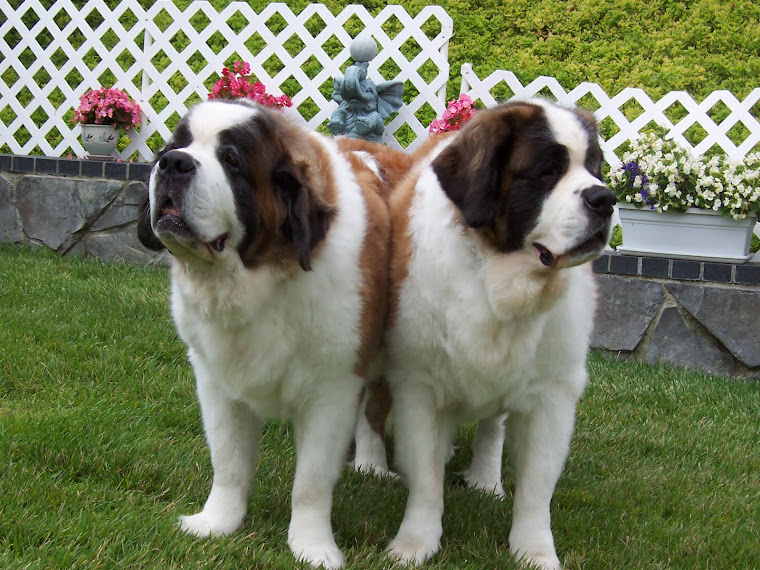The hospice and monastery was founded by an Augustine monk named, St. Bernard de Menthon; around the year 1050. The Great Saint Bernard Pass has always been a treacherous place for travelers, the hospice provided help to those traveling through the area.
It is believed that sometime between 1660 and 1670 that the monks at the monastery acquired their first Saint Bernards. These Saint Bernards are believed to have been descendants of the mastiff style Asiatic dogs brought into the area by the Romans. These early Saint Bernards looked quite a bit different from our Saints of today; brown and white fur, and their tails were a bit longer.
Around the early 1700's, marroniers were routinely accompanied by the Saint Bernard dogs in the pass area. The dog's wide chest helped to clear the snowy path. At this time it became apparent that the Saint Bernard had a keen sense of smell; which allowed them to find people buried deep in the snow. Two or three Saint Bernard dogs would be sent out alone to seek out lost or injured travelers and rescue them.
During the next 150 years, Saint Bernards made rescues in the Great Saint Bernard Pass area. Once the dogs found someone; they would dig through the snow and then lie on top of them providing some much needed warmth. The other dog would return to the monks to let them know of their find.
Between 1790 and 1810, Napoleon and his soldiers traversed the Pass area many times; it is well documented how many lives were saved by this noble breed. It is said that during those years not one soldier lost his life in the Great Saint Bernard Pass, due to the heroic saving ability of the Saint Bernard.
Most everyone has heard of Barry; the Saint Bernard who lived at the monastery from 1800 to 1812. Barry is credited with saving more than 40 people. Barry has been on display at the Natural History Museum in Berne, Switzerland since 1815.
Saint Bernards have been credited with rescuing over 2000 people over the years. The last documented rescue was in 1897; when a 12 year old boy was found nearly frozen in a crevice by a Saint Bernard.
Bamse was a well-known Saint Bernard mascot for the Free Norwegian Forces during World War II. Bamse is a Norwegian word which means teddy bear.
Captain Erling Hafto was Bamse's owner; he was also the master of the Norwegian whale catcher, Thorodd. Soon after the start of World War II; the Thorodd was drafted by the Royal Norwegian Navy to act as a coastal patrol vessel. Bamse became an official member of the crew on February 9, 1940. The Thorodd was used as a patrol vessel, POW transport, and as a minesweeper.
Bamse was a wonderful morale booster for the crew; he was also well-known by the civilian population in the area. He was often seen on the front gun tower of the boat during a battle; the crew made him a metal helmet for protection. Bamse performed several acts of heroism and community service as well.
Bamse was not only the mascot of the Thorodd and the Royal Norwegian Navy; he became the mascot for all the Free Norwegian forces.
The picture above shows crew members from the Thorodd giving Bamse a bath. I am sure Bamse made sure the crew members bathing him got wet as well.
Bamse died from heart failure on July 22,1944; he was seven years old. He received a military funeral with full honors. Hundreds attended his funeral; Norwegian sailors, Allied servicemen, local school children and townspeople as well.
Bamse was posthumously awarded the Norges Hundeorden on September 30, 1984 for his war service; he also received the PDSA Gold Medal in 2006 (known as George Cross for "animals"). Bamse was the only animal during World War II to receive the PDSA Gold Medal Honor. A large bronze statue of Bamse was unveiled on October 17, 2006; it stands at Wharf Street in Montrose.
A duplicate bronze statue of Bamse stands in Honningsvåg; Bamse's birthplace. The original statue of Bamse in Montrose looks north east toward Honningsvåg; the duplicate statue in Honningsvåg looks south west toward Montrose.
The duplicate bronze statue of Bamse was unveiled by schoolchildren from Honningsvåg and Montrose on June 19, 2009. Bamse was a wonderful ambassador for heroism and the wonderful Saint Bernard breed.










No comments:
Post a Comment
Note: Only a member of this blog may post a comment.